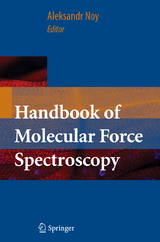Handbook of Molecular Force Spectroscopy
Springer-Verlag New York Inc.
978-0-387-49987-1 (ISBN)
Molecular force spectroscopy measurements have been very important for studies of adhesion and friction forces, where they provided the first truly nanoscale capabilities. Force spectroscopy has been instrumental in understanding mechanical properties and nanoscale dynamics of polymer systems from elasticity to nanoscale phase segregation. In biophysics, applications range from probing protein folding to direct mapping of intermolecular interaction potentials. This volume presents a review of modern force spectroscopy, including fundamentals of intermolecular forces, technical aspects of the force measurements, and practical applications. The Handbook begins with a review of fundamental physics of loading single and multiple chemical bonds on the nanometer scale with a discussion of thermodynamic and kinetic models of binding forces and dissipation effects in nanoscale molecular contacts, covers practical aspects of modern single-molecule level techniques, and concludes with applications of force spectroscopy to chemical and biological processes. Computer modeling of force spectroscopy experiments is addressed as well. In sum, Handbook of Molecular Force Spectroscopy is a comprehensive, authoritative guide to planning, understanding, and analyzing modern molecular force spectroscopy experiments with an emphasis on biophysical research.
Surface force apparatus measurements of molecular forces in biological adhesion
(Deborah Leckband, Univ. of Illinois, Urbana-Champaign).- Force spectroscopy with optical and magnetic tweezers (Richard Conroy, Harvard University).- Chemical Force Microscopy 1: Nanoscale probing of fundamental chemical interactions (Aleksandr Noy, LLNL, Dmitry V. Vezenov, Harvard University, and Charles M. Lieber, Harvard University).- Chemical Force Microscopy 2: Interactions in complex molecular assemblies (Dmitry V. Vezenov, Harvard University, Aleksandr Noy, LLNL, and Charles M. Lieber, Harvard University).- Dynamic force spectroscopy with the atomic force microscope (Phil Williams, University of Nottingham).- Simulation in force spectroscopy (David L. Patrick, Western Washington University).- Probe tip functionalization: applications to chemical force microscopy (Craig D. Blanchard, Albert Loui, and Timothy V. Ratto, LLNL).- The dynamical response of proteins under force.- (Kirstine L. Anderson, Sheena E. Radford, D. Alastair Smith, and David J. Brockwell, University of Leeds).- Counting and breaking single bonds: Dynamic force spectroscopy in tethered single molecule systems (Todd A. Sulchek, Raymond W. Friddle, and Aleksandr Noy, LLNL).- Direct mapping of intermolecular interaction potentials (Paul D. Ashby, MIT)
| Erscheint lt. Verlag | 4.12.2007 |
|---|---|
| Zusatzinfo | 150 Illustrations, black and white; XII, 300 p. 150 illus. |
| Verlagsort | New York, NY |
| Sprache | englisch |
| Maße | 178 x 254 mm |
| Themenwelt | Naturwissenschaften ► Chemie ► Analytische Chemie |
| Naturwissenschaften ► Chemie ► Physikalische Chemie | |
| Naturwissenschaften ► Physik / Astronomie ► Atom- / Kern- / Molekularphysik | |
| Technik ► Maschinenbau | |
| ISBN-10 | 0-387-49987-3 / 0387499873 |
| ISBN-13 | 978-0-387-49987-1 / 9780387499871 |
| Zustand | Neuware |
| Haben Sie eine Frage zum Produkt? |
aus dem Bereich




